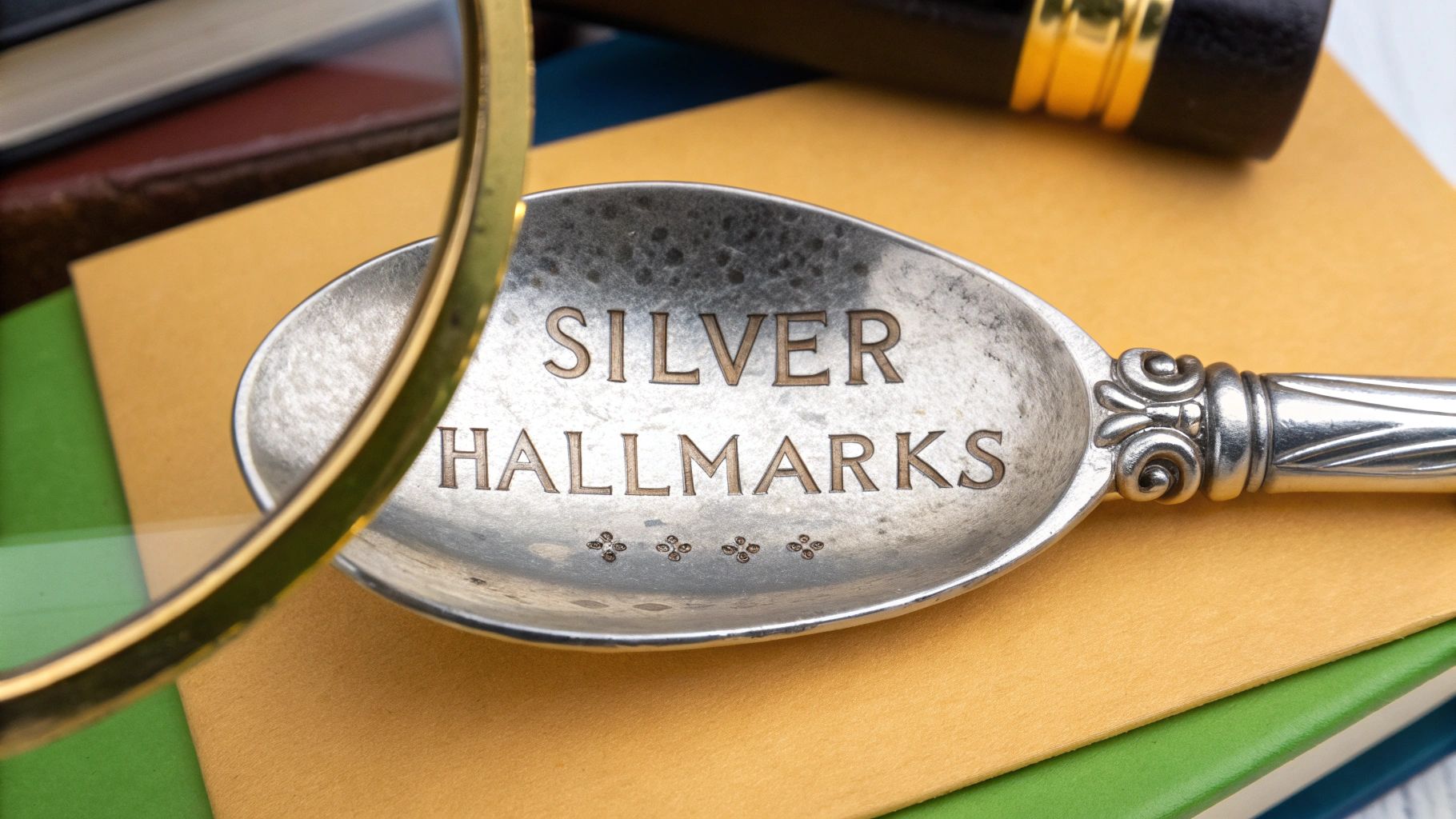Have you ever squinted at the tiny, intricate stamps on the back of a silver spoon or the bottom of a silver candlestick? They can look like a jumble of miniature pictures and letters, but they're not just decoration. They're a secret language.
These little stamps are called hallmarks, and they are your single best clue to an object’s story. Think of them as a passport for your silver. They’re an official guarantee of the silver's purity, and they can tell you exactly where, when, and sometimes even by whom the piece was made.
Your Quick Guide to Reading Silver Hallmarks
Learning to read hallmarks is like learning to read a map. At first, it's just lines and symbols, but once you know what to look for, a whole world of information opens up. Each tiny stamp is a piece of the puzzle, and together, they tell a fascinating story about your item's past.
This skill is the foundation of antique identification. It turns a mystery object into a tangible piece of history with a clear timeline and origin. It’s a crucial part of the process we cover more broadly in our guide on how to identify antiques.
The Four Core Types of Silver Hallmarks
While hallmarking systems can differ from country to country, the classic British system set a standard that many others followed. It's built around four (and sometimes five) key marks. Getting familiar with these will let you decipher the vast majority of antique silver you come across.
Let's break down the most common types of marks you'll find. This table gives you a quick-reference guide to what each symbol means.
| Hallmark Type | What It Tells You | Common Symbol Examples |
|---|---|---|
| Standard Mark | Confirms the metal meets a legal standard of purity. | The Lion Passant for British sterling silver (92.5%). |
| Assay Office Mark | Shows the specific city where the silver was tested and marked. | A leopard's head for London, an anchor for Birmingham. |
| Date Letter | A letter in a specific shield and font style that pinpoints the exact year. | An "A" in a square might be 1776, while a cursive "a" is 1816. |
| Maker's Mark | The initials or symbol of the silversmith or workshop that made the piece. | "P.S." for the legendary silversmith Paul Storr. |
Once you see them in action, you realize how these marks work together to provide a complete biography for a piece of silver.
While we're focusing on silver here, the concept of marks applies to other precious metals too. If you're curious about jewelry more generally, this external resource is a fantastic starting point: Identifying Jewelry Hallmarks: A Quick Guide to Reading Marks.
The 700-Year History of Silver Hallmarking
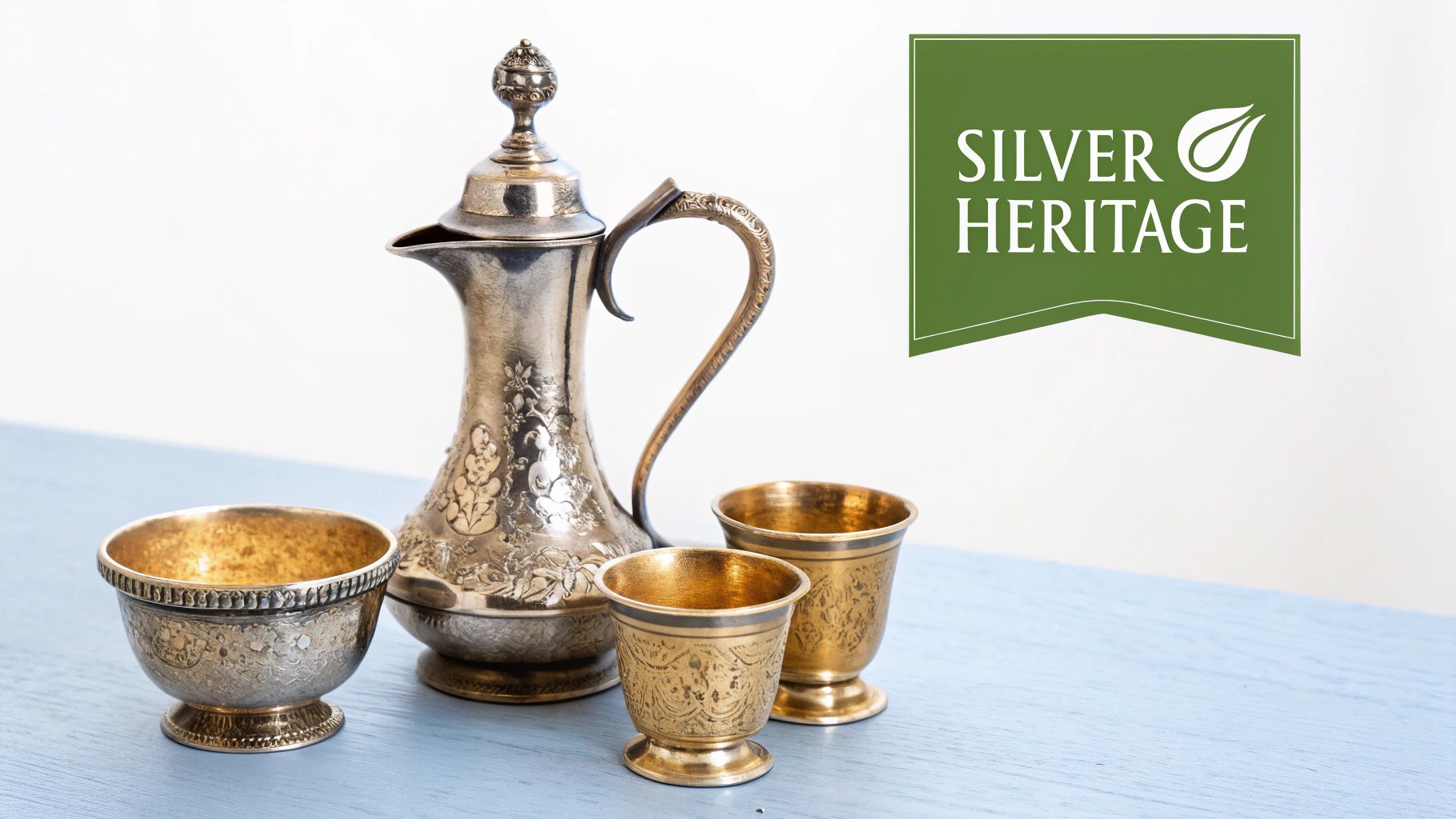
To really get what hallmarks are all about, you have to picture a world without them. Think of a crowded medieval market. No big brand names, no consumer protection laws. If you wanted to buy a silver goblet, how could you be sure you weren't getting a cheap metal with a thin silver coating? It was a real problem.
This is exactly why hallmarking was invented. It's one of the oldest forms of consumer protection in history, born out of a need for trust. It wasn’t just about fancy stamps; it was about guaranteeing honesty. Silversmiths' guilds, along with smart rulers, figured out that an official, verified mark could separate the honest craftsmen from the frauds and give buyers peace of mind.
The Foundation of a Sterling System
While people had been marking precious metals since at least the 4th century AD (as seen on old Byzantine silver), the system we recognize today really took shape in England. The big moment came in 1300, when King Edward I passed a law that created a reliable, long-lasting way to certify silver. You can dive deeper into the specifics by reading this historical overview of early hallmarking standards.
This groundbreaking law set a standard that still matters worldwide. It mandated two crucial things:
- The Sterling Standard: Every piece of silver had to contain at least 92.5% pure silver. This benchmark is what we now know as "sterling silver."
- The Leopard's Head: A special group of wardens from the Goldsmiths' Guild in London was put in charge of testing the silver. If an item passed, they stamped it with a leopard’s head. This was the official seal of approval.
A Legacy of Trust That leopard's head was more than just a picture. It was a promise. It signaled to everyone that the piece had been independently tested and met the highest standard of the time. It turned a beautiful object into a verified and trustworthy asset.
How the System Evolved
This simple two-part system was just the beginning. Over the next few centuries, more marks were added, making the story told by hallmarks even richer. First came the maker's mark, which identified the silversmith who crafted the piece, holding them personally accountable for their work.
Then came the date letter, which pinpointed the year the item was assayed. As the silver trade grew, other cities like Birmingham and Sheffield opened their own assay offices, each adopting a unique town mark. What started as a simple purity stamp evolved into a complete "passport" for every piece of silver, detailing its quality, maker, location, and age—a system of trust built over 700 years that we can still read today.
How to Decode British Silver Hallmarks
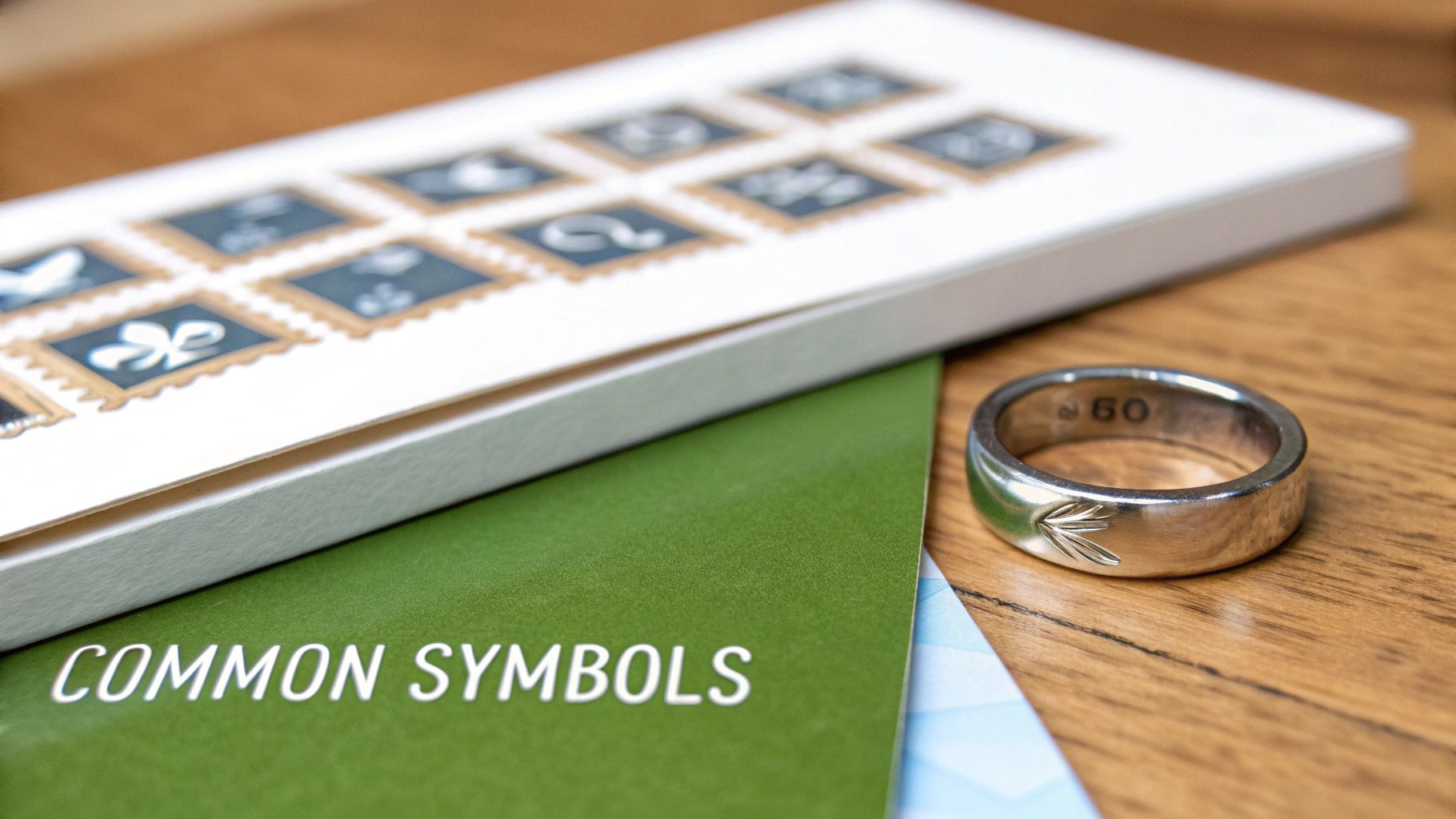
Think of British hallmarks as a secret language stamped right into the silver. Once you learn to read the symbols, you can unlock the entire story of a piece. Thankfully, the British system is one of the most consistent and well-documented in the world, making it a fantastic starting point for any aspiring silver detective.
Most British silver you'll encounter will have at least four key marks punched into it. Each one answers a specific question—who, what, where, and when. Together, they build a complete profile of the item right before your eyes.
Let's break down exactly what you should be looking for.
The Four Essential Marks
The classic British system is built on a foundation of four symbols working in harmony. Finding and identifying each one is the key to piecing together your silver's history.
- The Purity Mark: This guarantees the silver content. The most common is the Lion Passant (a walking lion), which certifies the piece is sterling silver, meaning it’s made of 92.5% pure silver.
- The Assay Office Mark: This tells you the city where the silver was tested and stamped. Every assay city has its own unique symbol, like the iconic leopard's head for London or an anchor for Birmingham.
- The Date Letter: This is a letter of the alphabet, but its font and the shape of the shield around it are just as important. This combination pinpoints the exact year the item was hallmarked.
- The Maker's Mark: These are simply the initials of the silversmith or the company that produced the item. Think of the famous "PS" mark belonging to the master silversmith Paul Storr.
A Story of Purity and Protection
This remarkably organized system has been governed by strict standards since the year 1300. It all started when King Edward I decreed that all silver had to meet the sterling standard. To enforce this, pieces had to be tested—or "assayed"—by wardens of the Goldsmiths' Guild, who used a 'leopard's head' stamp.
Over the centuries, other assay offices opened in major cities like Sheffield and Edinburgh. There was even a brief period between 1696 and 1720 when a higher Britannia standard (95.8% silver) was required to stop people from melting down the nation's silver coinage. You can dive deeper into the history of these comprehensive silver regulations on AntiquesTradeGazette.com.
This long, unbroken history of regulation is precisely why British hallmarks are so trusted. They represent centuries of guaranteed quality and consumer protection, all stamped into a tiny space.
Putting It All Together Imagine you find an old silver spoon. You spot a walking lion (sterling purity), a leopard's head (London), the letter 'A' in a distinctive square shield (1776), and the initials 'WB' (William Bateman). Just like that, you know you're holding a sterling silver spoon made in London by William Bateman in 1776. The mystery is solved!
Spotting Exceptions and Special Marks
While those four marks are your main guide, you might occasionally find others. For example, a sovereign's head mark was used between 1784 and 1890 to show that a tax had been paid on the item.
You might also see pieces made to the higher Britannia standard. Instead of the usual Lion Passant and leopard's head, these will feature a figure of Britannia and a lion's head erased (a lion's head in profile). Learning to recognize these variations helps you build a more complete and accurate picture of your silver's identity and origin.
Identifying International Silver Marks
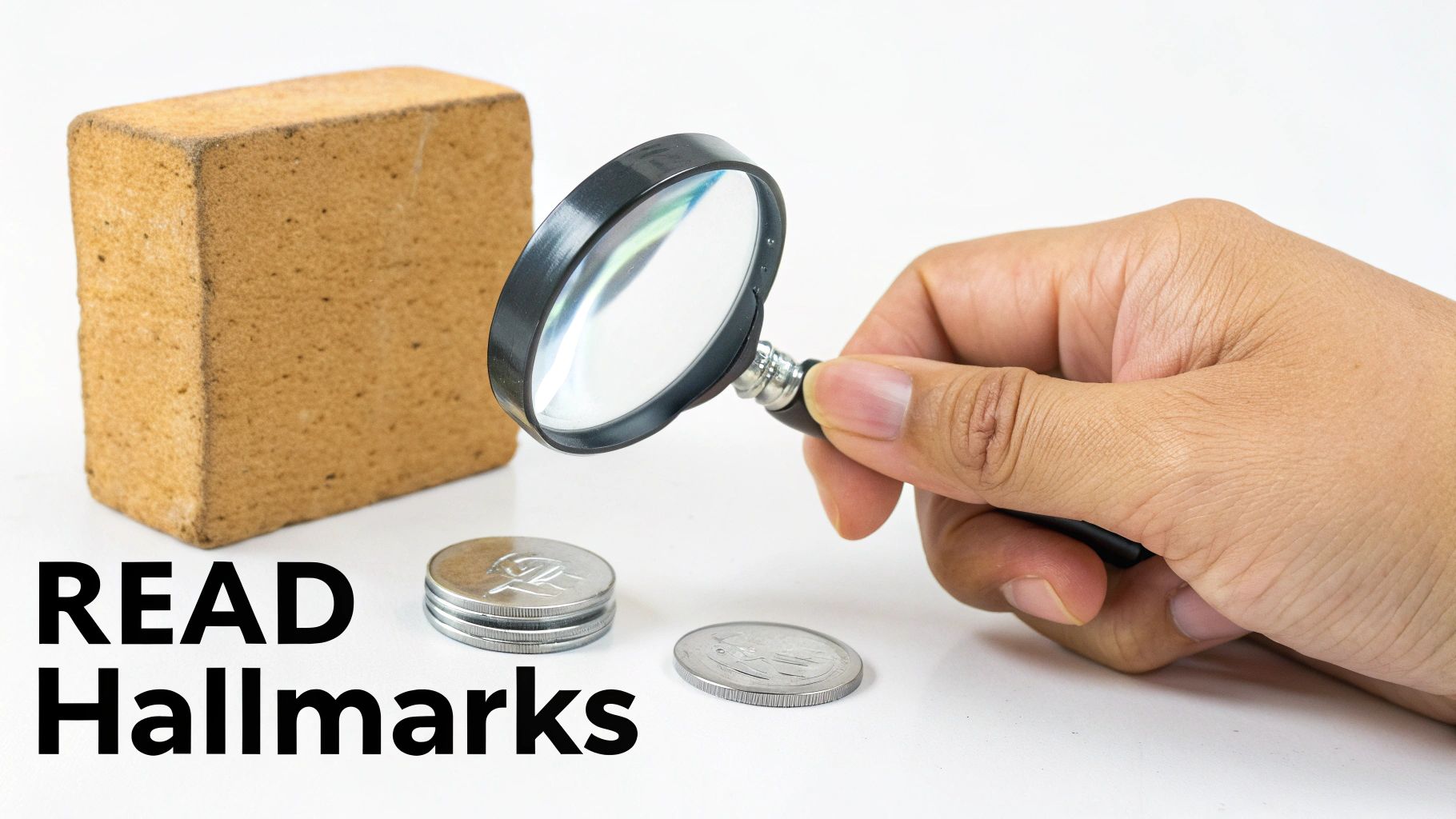
If you’ve just gotten the hang of the wonderfully detailed British hallmarking system, it's easy to feel like you've cracked the code for all silver. But the moment you encounter a piece from outside the UK, you realize you're playing a whole new ball game. It’s a bit like learning a new language; knowing English is great, but it won’t help you much when you’re trying to read French or German. The same goes for silver marks.
Different countries developed their own unique systems over the centuries. While they all share the same goal—guaranteeing the purity of the silver—their methods and symbols couldn't be more different. Getting to know these international variations is the key to identifying silver from around the world and avoiding the common pitfall of dismissing a piece just because it lacks the familiar Lion Passant.
Key International Hallmarks to Know
Diving into international silver marks is like opening a new chapter in your collecting journey. Instead of a neat set of four or five stamps, you might only find one or two. Don't let that throw you off.
Here are a few of the most common marks you'll come across from major silver-producing regions:
French Silver: Keep an eye out for the Minerva head hallmark. This iconic symbol, used throughout much of the 19th and 20th centuries, was France's guarantee of silver purity. You'll often see a small number next to it: a "1" means the piece is .950 silver (even higher than sterling!), while a "2" signifies .800 silver.
German Silver: German pieces often bear a crescent moon and crown (the Reichskrone). This national mark, introduced after 1886, is almost always paired with a number like "800" or "925," which clearly states the silver content in parts per thousand.
American Silver: The United States took a much different approach. With no government-run assay office system like Britain's, American silversmiths simply stamped their pieces with terms like "Sterling," "STER," or the number "925." This was usually accompanied by their own maker's mark, such as the famous Tiffany & Co. or Gorham.
Common International Silver Hallmarks at a Glance
Navigating the world of international silver can feel a bit overwhelming at first. This table provides a quick reference to help you start recognizing some of the most common symbols you're likely to encounter.
| Country | Common Purity Mark/Symbol | Typical Information Provided |
|---|---|---|
| France | Minerva Head with a number "1" or "2" | Guarantees minimum purity (.950 or .800) and sometimes includes a separate maker's mark. |
| Germany | Crescent Moon & Crown | This national mark is paired with a numerical purity stamp (e.g., 800, 835, 925). |
| USA | "Sterling," "STER," or "925" | Indicates .925 purity and is usually accompanied by a manufacturer's mark. |
| Denmark | Three Towers | Represents the city of Copenhagen. Often includes the last two digits of the year and a maker's mark. |
| Russia | "84" Zolotnik mark (pre-1917) | Indicates .875 silver purity. Often found with a city mark and assayer's initials. |
This is, of course, just a starting point. Each system has its own rich history and nuances, but knowing these key symbols will give you a massive head start.
Decoding Purity Numbers and Systems
Across Europe and beyond, you'll see a variety of numerical marks. While the British stuck to symbols, many other countries preferred to stamp the exact purity. In Denmark, for example, the hallmarking system has been remarkably consistent since 1888, usually including a maker’s mark and a clear purity stamp in thousandths.
Sometimes you'll find numbers that denote a slightly lower silver content than sterling, which was common in continental Europe. For instance, understanding what 835 means on jewelry helps you identify pieces made to a popular standard in countries like Germany and the Netherlands.
A Note on Global Variations The absence of a full set of four or five hallmarks doesn't mean a piece is fake or less valuable. It simply means it was made under a different country's rules. Learning to recognize these international systems is a crucial skill for any serious collector.
This global perspective is a powerful tool in your antique-hunting arsenal. It perfectly complements the skills needed to find all kinds of treasures, a topic we cover in our guide on how to identify valuable antiques. By learning the marking customs of different nations, you'll be far better equipped to uncover the story behind any piece of silver you find, no matter where it's from.
Why Hallmarks Dictate the Value of Your Silver
So, you’ve learned how to read all those tiny stamps. Now for the big question: why does any of it really matter? It’s simple, really. Hallmarks are the single most important key to unlocking the true value of any silver piece.
These little marks are what turn a pretty object into a documented piece of history. They give it a verifiable identity, which has a direct and often dramatic impact on its price.
Imagine finding two antique silver spoons that look almost exactly alike. One has no marks at all—it's a nice, but ultimately anonymous, piece of old silverware. The other, however, has a clear set of hallmarks identifying it as the work of a famous 18th-century master like Paul de Lamerie. Suddenly, that second spoon isn't just cutlery anymore. It's a collectible work of art. The only difference is the hallmarks, but that difference could be worth thousands of dollars.
The Anatomy of Silver Value
The value of a silver piece is almost never just about how much the metal itself is worth. It’s a combination of different factors, and the hallmarks are what prove every single one of them. They provide the concrete evidence that appraisers and collectors need.
A clear, complete set of marks answers all the important questions at a glance:
- Purity: Is it sterling (92.5% silver), or is it a lower-grade alloy?
- Age: Was this made in 1720 or 1920? An older date often means higher value.
- Origin: Did it come from a prestigious assay office like London, or a more common one?
- Maker: Was this crafted by a famous silversmith or an unknown workshop?
The Hallmark is the Pedigree Think of it like a pedigree for a champion show dog. Without the official papers to prove its lineage, it’s just another dog. With those papers, it’s a recognized champion. Hallmarks provide that same level of documented proof for silver.
When Marks (or a Lack of Them) Affect Worth
The condition of the hallmarks is just as important as their presence. A worn, smudged, or illegible mark creates doubt. If you can’t prove the story of the piece, its value can take a hit. On the other hand, a crisp and clear set of marks is a huge plus for collectors.
This is exactly why figuring out what your antique is worth takes more than a quick look. While we're talking about silver here, understanding how purity and metal type affect value is true for all kinds of fine jewelry. To see how this applies elsewhere, it's helpful to understand the properties of different precious metals like white gold and platinum.
Ultimately, knowing how to read these marks is what empowers you to tell the difference between a true treasure and a simple trinket. It’s the skill that connects all the dots.
Common Questions About Silver Hallmarks
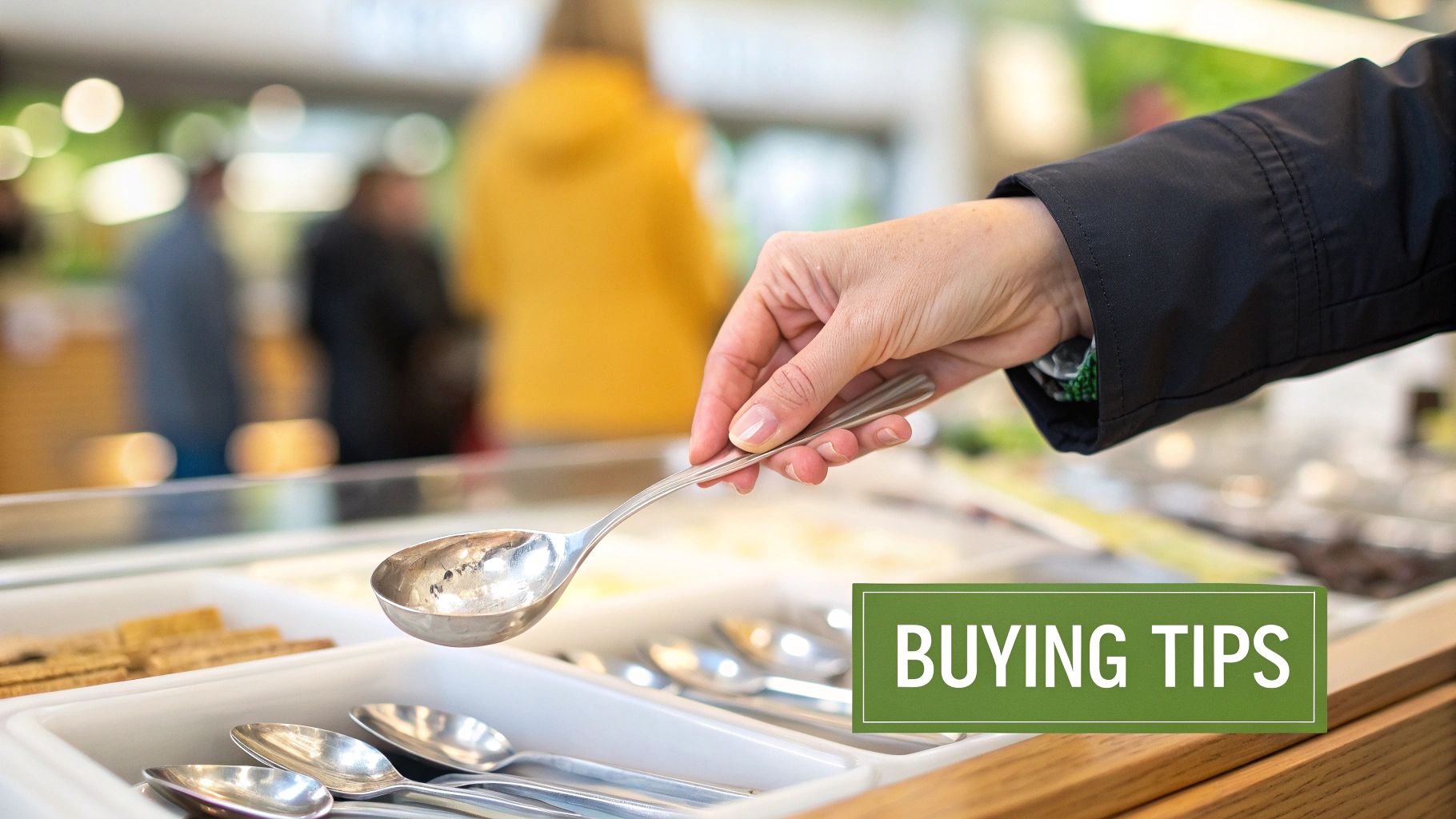
After exploring 700 years of silver history and learning to decipher marks from around the world, you're bound to have some specific questions. It's one thing to understand the system, but another to apply it to that strange spoon or tarnished tray sitting in front of you.
This section tackles some of the most common puzzles collectors and enthusiasts run into. Think of it as a quick field guide for those lingering hallmark mysteries.
What If My Silver Has No Hallmarks at All?
Discovering a piece with no marks can be puzzling, but don't jump to conclusions just yet. It doesn't automatically mean it's not silver. The item could be from a country that never had a mandatory hallmarking system, or it could be silverplate in disguise.
First, give the piece a thorough inspection under a bright light. Look for any other kinds of stamps, like the word "Sterling" or a number like "925." If you come up completely empty, it's more likely to be silverplate (which might be stamped "EPNS") or another metal entirely. The only way to know for certain is to have it professionally tested by a jeweler.
How Do I Identify the Maker's Mark?
Figuring out the maker's mark—usually a set of initials—is often the most satisfying part of the hunt. It’s the final clue that connects your item to a real person or workshop from the past.
The best way to do this is with a bit of detective work and a good online database. Here's how I usually approach it:
- Pinpoint the Assay Office: First, find the town mark, like the leopard's head for London.
- Lock Down the Year: Next, match the date letter to its corresponding year.
- Search the Database: With the city and year nailed down, you can search a hallmark resource for the specific initials on your piece.
Specialized websites for British and international silver are your best friends here. They have vast records that link thousands of makers' initials to specific time periods and locations.
Are Marks Like EPNS or A1 Silver Hallmarks?
In a word, no. These marks are a dead giveaway for silver plating, not solid sterling silver. They are completely separate from the official hallmarking system, which only exists to certify the purity of solid precious metals.
Key Distinction for Value Getting this right is absolutely crucial for valuation. 'EPNS' means Electro Plated Nickel Silver, and grades like 'A1' or 'Quadruple Plate' just indicate how thick the silver coating is. While often beautifully crafted, plated items simply don't have the intrinsic value of hallmarked sterling silver.
Do Modern Silver Items Still Get Hallmarked?
Yes, absolutely! The hallmarking tradition is very much alive and kicking. In the UK, for example, it's still a legal requirement to hallmark any new silver item sold that weighs more than 7.78 grams.
These modern marks fulfill the exact same function they have for centuries: providing a bulletproof guarantee of the silver's quality and origin. While the techniques have evolved—you'll now see crisp laser engravings alongside traditional hand-punched marks—the system of trust is the same. A hallmark from 2024 is just as meaningful as one from 1724. It’s the ultimate stamp of authenticity.
Feeling overwhelmed by the treasures you've inherited or found? The Curio app turns mystery into clarity. Just snap a photo to instantly identify your antiques, learn their history, and get an estimated value. Download Curio today and let your antiques tell their story.
Find out more at https://www.curio.app.
